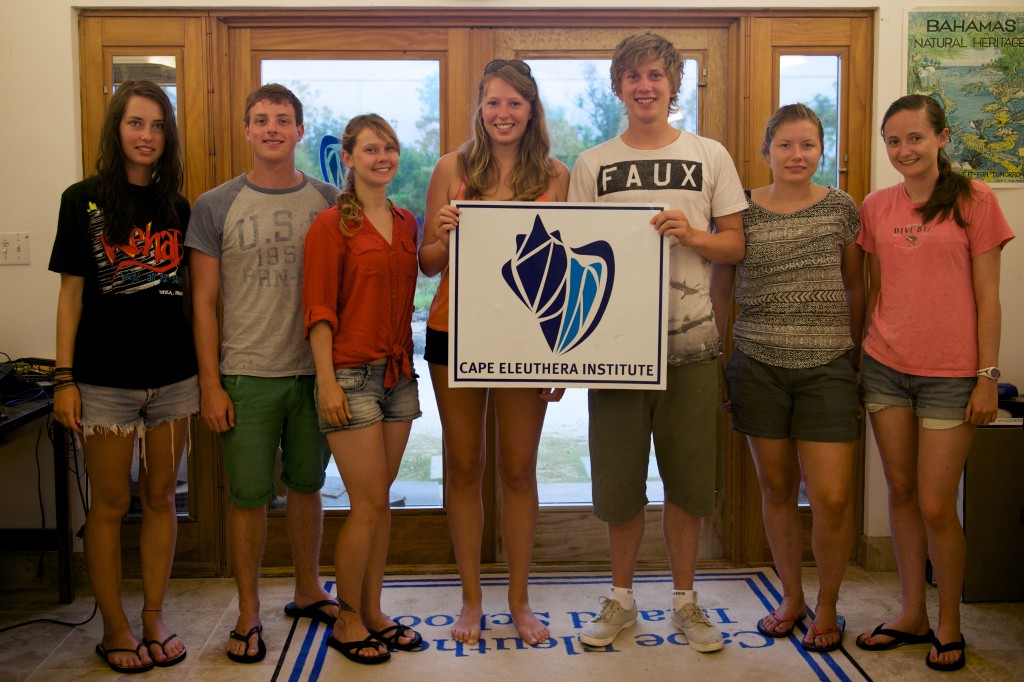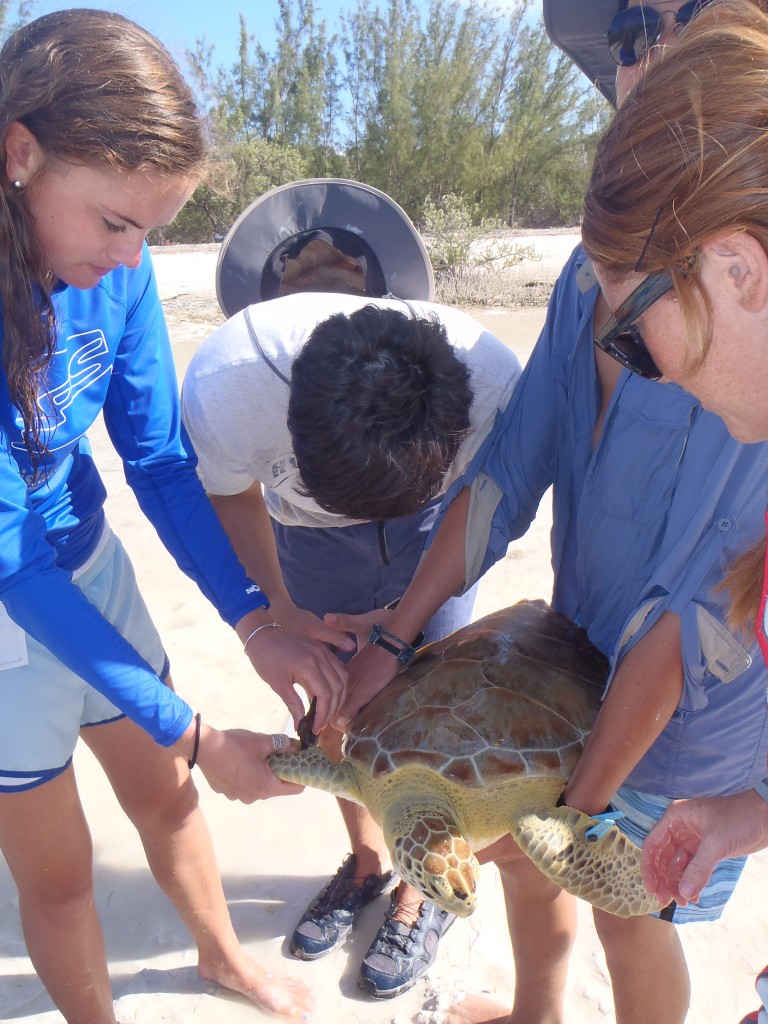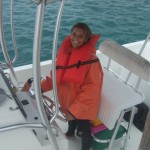Seven undergraduate students from Newcastle University have been on campus since July 1, assimilating with various research groups at CEI. Each student is working on an individual project for their undergraduate thesis. Click below for a summary of the projects:
Category Archives: Flats
CEI’s Flats Program releases The Bahamas’ second largest bonefish tagged to date
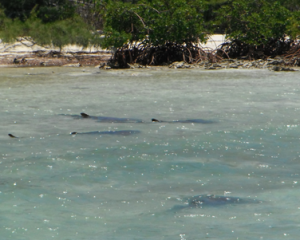
This June, The Flats Ecology Program (FECP) continued its bonefish tagging efforts as part of The Bahamas Initiative, an ongoing project between CEI, the Fisheries Conservation Foundation, and the Bonefish and Tarpon Trust, to assess population size, movements, and growth of The Bahamas’ bonefish population. The latest tagging efforts on Grand Bahama Island, funded in part by The Moore Foundation, brought a close to the six week research expedition across The Bahamas by CEI and Stony Brook University researchers (see “Shark Expedition” updates below).
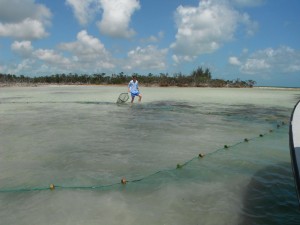
CEI researcher Zach Zuckerman and FECP collaborator Justin Lewis first targeted bonefish near Lucayan National Park along the southern shore of Grand Bahama. Due to high winds and pounding surf, the researchers trailered their boat to the southeastern tip of the Island, near Deep Water Cay, and almost immediately spotted schools of fish. To capture bonefish, the researchers quickly and stealthily unravel a 150 ft. net a distance in front of the school, then rush to encircle the fish. The fish are allowed a few minutes to settle down before individuals are hand netted from the school, length measurements recorded, sex determined based on the presence of milt (sperm) or eggs, and an external tag embedded in the dorsal muscle of the fish. The tag has both a unique number and contact information printed on it so that fishermen and guides can report when and where fish are recaptured, thus providing The Bahamas Initiative tagging program with invaluable data on growth and movement.
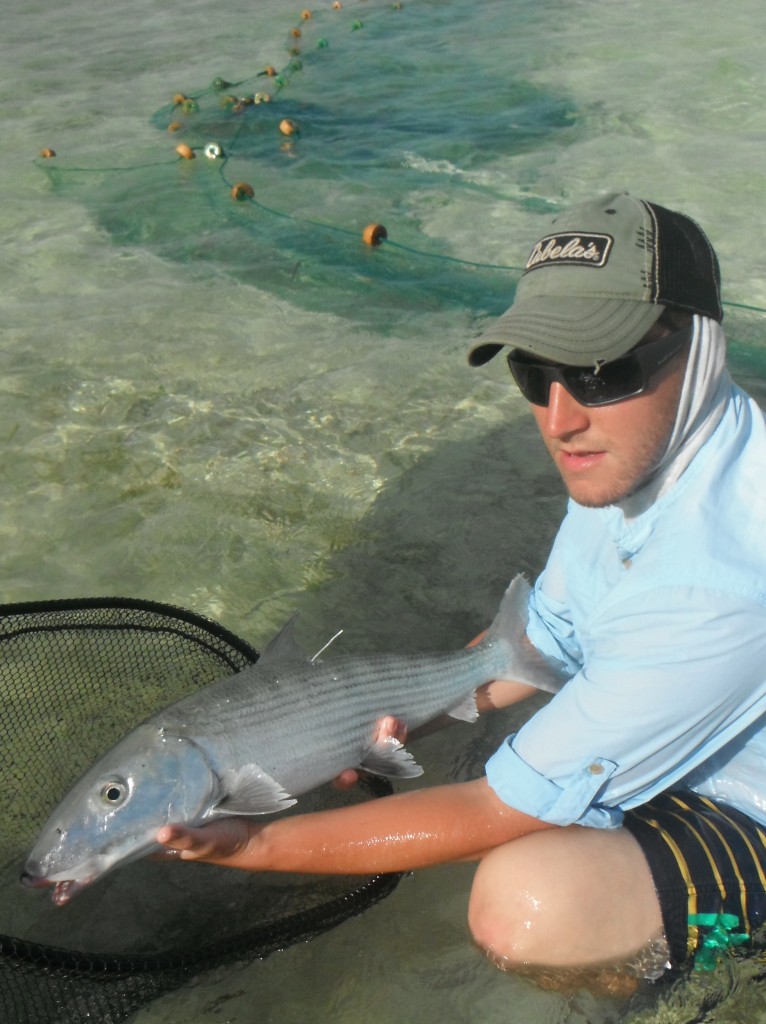
A total of 102 fish were captured, three of which had been previously tagged. Included in the 99 newly tagged individuals was a whopping 67.2 cm (26.5 in) fish estimated at 11 pounds – the second largest bonefish tagged to date in The Bahamas! In addition to bonefish, several juvenile and adult lemon sharks and bonnethead sharks were also tagged along the northern shore of the island with the assistance of guides from H2O Bonefishing, Freeport. Continue reading
Stress and the Incredible Checkered Puffer
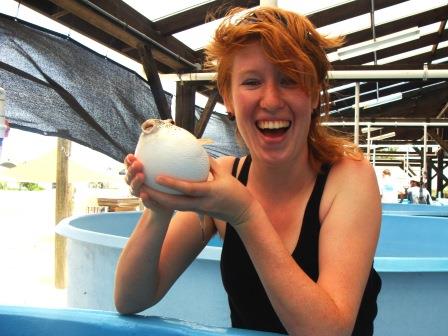
How do fish handle stress? With the rise of human and climate related stressors, researchers are actively exploring how fish react to these conditions. Naomi Pleizier, a MSc. student from the Cooke Lab at Carleton University, Ottawa, Canada, ventured to CEI to discover how short-term stress affects the long-term fitness of one of the mangrove ecosystem’s most charming residents, the checkered puffer fish (Sphoeroides testudineus).
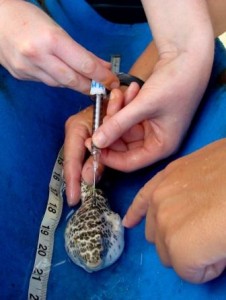
Adapted to the dynamic mangrove habitat, checkered puffers are well equipped to handle the fluctuating environment and the threat of predators. This species has an amazing tolerance of a range of salinities and temperatures. Predators must beware of these harmless looking little fish; not only do they puff to an incredible size in response to threats; they are also rendered toxic by the plankton living in their tissues. Not only that, but they have a mean bite, as study volunteers can attest to!
The puffers’ active responses to predators make them an excellent candidate for the study of stress. The research team collected puffers from Paige Creek and transported them to the CEI lab for treatment. Continue reading
Deep Creek Kids Discover the Life in the Creeks
Last week our Educational team led a three day natural history camp for nine kids from Deep Creek and the surrounding settlements. In addition to camp songs, rounds of the game ‘screaming toes’ and scavenger hunts, our educators introduced students to the terrestrial and marine life on the shores of Red Bays, Deep Creek and Paige Creek.
Adventure Log
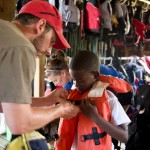 Day 1: After intros and icebreakers we went to the beach to do a scavenger hunt, and build our own mangroves on the beach. In the afternoon, the group learned how to identify the red, white and black mangrove trees of Deep Creek and explored the slippery, slimy mud found here.
Day 1: After intros and icebreakers we went to the beach to do a scavenger hunt, and build our own mangroves on the beach. In the afternoon, the group learned how to identify the red, white and black mangrove trees of Deep Creek and explored the slippery, slimy mud found here.
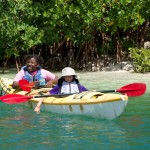 Day 2: A field trip to the Island School! The kids learned how to work together to move kayaks, both in the water and on land! After all that hard work in the morning, we hiked up Paige Creek and lazily floated out with the tide, identifying fish and invertebrates along the way.
Day 2: A field trip to the Island School! The kids learned how to work together to move kayaks, both in the water and on land! After all that hard work in the morning, we hiked up Paige Creek and lazily floated out with the tide, identifying fish and invertebrates along the way.
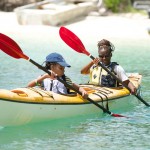 Day 3: On our final day of camp, we went seining in the creeks with two of our interns, Stephen and Liam. After a couple of attempts, we successfully caught several species of fish and learned how climate change is affecting fish in these creeks – research our Flats team is currently conducting at CEI. After a picnic lunch in Deep Creek, the group showcased what they’d learned about life in the mangrove ecosystem by creating posters depicting the life found there.
Day 3: On our final day of camp, we went seining in the creeks with two of our interns, Stephen and Liam. After a couple of attempts, we successfully caught several species of fish and learned how climate change is affecting fish in these creeks – research our Flats team is currently conducting at CEI. After a picnic lunch in Deep Creek, the group showcased what they’d learned about life in the mangrove ecosystem by creating posters depicting the life found there.
Pacific Ridge School experiences the Atlantic 2013
The past 12 days have been a whirlwind for a group of 15 students from Carlsbad, Northern San Diego, California. The first week of the program, the students embarked in discovering all the different research areas that CEI is currently involved in. These are just a few of the plethora of activities that we delved into: snorkelling the cage, cutting glass with Sam for the new resource building, jumping off high rock, playing in the pink sand on Harbour Island, observing echinoderms and their tubed feet frenzy over on the sand bar, night wading around the boathouse, followed by many more.
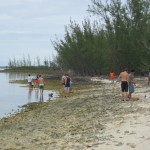
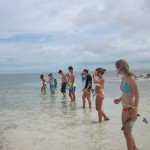 On day one we were out with the flats team seining in some adverse conditions. The rain held us indoors for a couple days, where the student’s day varied from discussing sustainability to dissecting a sponge and learning all about the critters that inhabit the watery pores of a lovely smelling stinker sponge!
On day one we were out with the flats team seining in some adverse conditions. The rain held us indoors for a couple days, where the student’s day varied from discussing sustainability to dissecting a sponge and learning all about the critters that inhabit the watery pores of a lovely smelling stinker sponge!
Spring 2013 CEI/IS Research Symposium was a success!
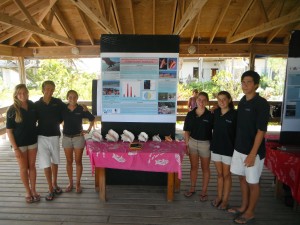
This past Saturday, CEI and IS hosted their Spring 2013 Research Symposium. The event consisted of research presentations and poster sessions, where Island School students got the chance to present their semester’s worth of work to staff, community members, visiting scientists, and representatives from some Bahamian NGO’s, including Save our Bays. After giving brief presentations that discussed everything from the purpose of the research to data analysis and interpretation, IS students had the chance to attend their first poster session as
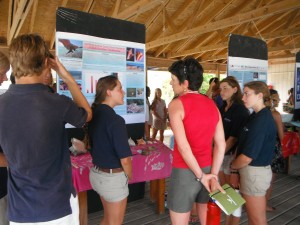
young scientists. After working on the posters all semester, students were proud to showcase their effort, and share what they learned with those that were interested. The Symposium culminated with keynote speakers Dr. John Tiedemann (Monmouth University) and Dr. Mark Hixon (University of Hawaii), addressing the students and motivating them to continue their critical thinking as they move on to college.
Parents Weekend Spring 2013
This past weekend, the CEI and Island School campus had many visitors eager to hear about CEI research- Island School parents! Parents attended presentations given by IS students on current research projects that the students have been working on since they arrived in March. Research presentations discussed during the event included:
- The abundance and distribution of sea turtles in Half Sound
- Effects of longline capture on shark physiology
- Competitive interactions between lobsters and lionfish
- Identifying ideal nursery habitat for juvenile queen conch
- Effects of climate change on bonefish and other mangrove species
- The relationship between herbivore abundance on patch reefs and proximity to mangroves
- Assessing settlement of post-larval lionfish
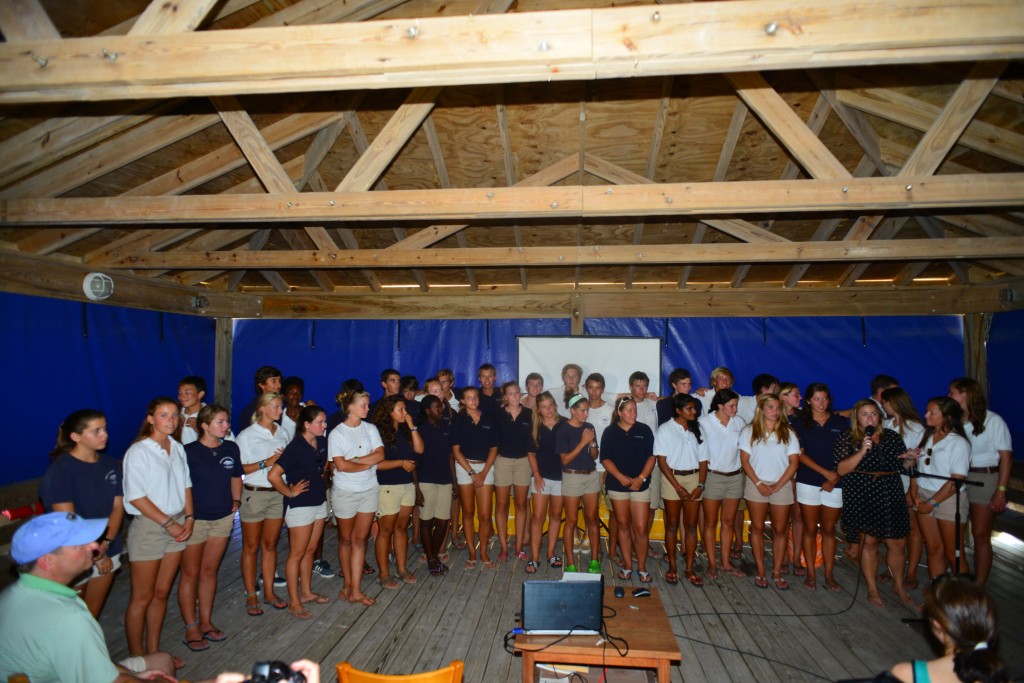
Each presentation was followed by a question and answer session, where students demonstrated their extensive knowledge on the background and applications of their study. Parents also got the opportunity to learn about all of the research happening at CEI, and to meet with research advisors.
Mangrove nursery established in McKinney Creek on the Island School campus
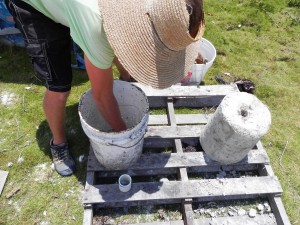 A new project focused on the rehabilitation of tidal mangrove creeks in South Eleuthera has been put into action by the Flats Ecology and Conservation Program. A part of this project is the establishment of a red mangrove nursery in the creek on campus. Armored cultivator pots have been built to house the young mangrove propagules which will be transplanted to areas that would benefit from the reestablishment of a mangrove forest once prop roots start to grow.
A new project focused on the rehabilitation of tidal mangrove creeks in South Eleuthera has been put into action by the Flats Ecology and Conservation Program. A part of this project is the establishment of a red mangrove nursery in the creek on campus. Armored cultivator pots have been built to house the young mangrove propagules which will be transplanted to areas that would benefit from the reestablishment of a mangrove forest once prop roots start to grow.
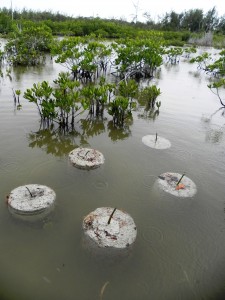 The initial plan for the armored cultivator pots was derived from a design used by the Mangrove Solutions Division of the Reef Ball Division. The cultivator pot acts as a growing medium for the propagule as it becomes established, and further acts as a protective shield once the young mangrove is transplanted to a predetermined area that would benefit from mangrove rehabilitation that may experience wave, wind, and tide action. We strive to use the highest percentage possible of locally sourced materials in the mixture and to include organic materials that provide nutrients to the plant as it grows. The mixture we have employed includes mud collected from the mangrove creek, sand, compost, shredded coconut husk, and Portland cement. Continue reading
The initial plan for the armored cultivator pots was derived from a design used by the Mangrove Solutions Division of the Reef Ball Division. The cultivator pot acts as a growing medium for the propagule as it becomes established, and further acts as a protective shield once the young mangrove is transplanted to a predetermined area that would benefit from mangrove rehabilitation that may experience wave, wind, and tide action. We strive to use the highest percentage possible of locally sourced materials in the mixture and to include organic materials that provide nutrients to the plant as it grows. The mixture we have employed includes mud collected from the mangrove creek, sand, compost, shredded coconut husk, and Portland cement. Continue reading
Bonefish tagging trip to Hummingbird Cay
The bonefish tagging project continues to study the movements, population size and structure, and the possible impacts of angling on these important fish. By capturing and tagging large numbers of bonefish at multiple sites throughout The Bahamas, we hope to better understand bonefish movements, as well as determine how many spawning aggregations exist and where they are located. This information can help identify coastal areas that should be protected.

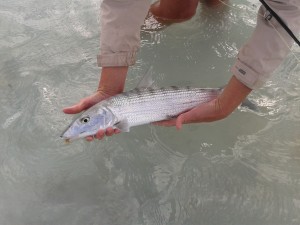
A team of scientists visited Exuma early this spring with hopes to expand the bonefish tagging program to this island. The team, consisting of Aaron and Brian Shultz (The Cape Eleuthera Institute), Dave Philipp, Julie Claussen, and Chris Haak (Fisheries Conservation Foundation), met up with the staff at Hummingbird Cay and were later joined by the family that owns the small island located to the west of Great Exuma. Brian Shultz conducted a sustainability audit for Hummingbird Cay, while the rest of the team surveyed the creek systems and tidal flats. The scientists also connected with several bonefish guides on Great Exuma to discuss the importance of the bonefish tagging program and the recent tagging efforts on other islands such as Abaco, Grand Bahama, and Eleuthera. Stevie Ferguson, Reno Rolle, Drexel Rolle and several other bonefish guides agreed to help capture and tag 500+ bonefish later this year. Overall, this was a very successful trip that would not have been possible without the support of the Hummingbird Cay Foundation and Exuma Foundation.
Deadlines extended for summer camps at at CEI!
Attention! Deadline for registration for CEI’s Eleutheran Explorer’s Camp, Shark Week, Flats Week, and the new Turtle Week has been extended to JUNE 15. Please see the links below for informational flyers about the camps!
